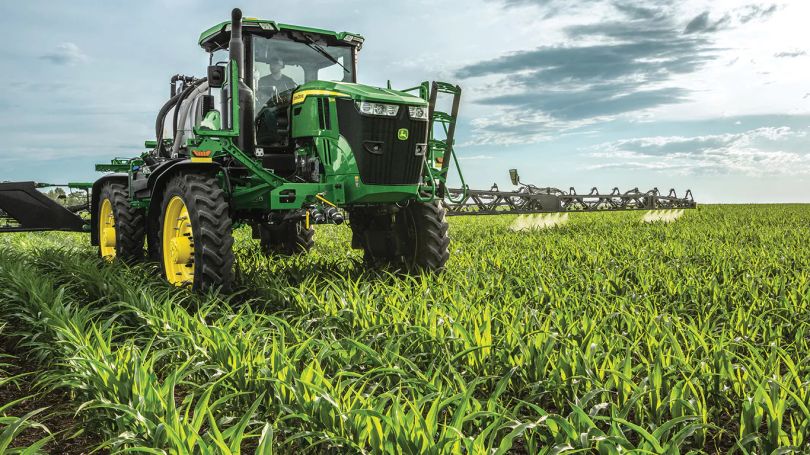In the glow of dawn, the familiar green silhouette of a John Deere sprayer glides over a furrowed field. Jets of carefully mixed herbicides sprinkle the fallow ground while the operator patiently guides the vehicle over each turret of earth.
But this is no ordinary farm vehicle.
Affixed at intervals along the carbon fiber boom are small cameras, which scan the unsown ground for signs of unwelcome weed growth. Using computer vision and machine learning, or CVML, the sprayer targets each errant plant with a precise blast of herbicide.
As a result of this “See & Spray” technology, the farmer uses 77 percent less product — combatting herbicide resistance, reducing costs and mitigating environmental impact with one well-placed spray. In a few weeks, the weeds will wilt and die, creating fertile space for healthy growth.
The bleeding-edge technology is John Deere’s sleek answer to precision farming, an emerging agriculture-management concept rooted in the variability of crops as the seasons shift. In precision farming methods, farmers quantify variable field conditions supported by in-field data collection, remotely sensed data or both.
“At the turn of the last century, decisions were made at a farm level,” explained John Deere Principal Architect Jason Wallin. “Next, evolution was about making each field effective.
“Today, farmers are managing crops at an individual plant level,” he continued. “Our IT projects closely parallel this evolution.”
“Decisions were previously made at a farm level. Next, evolution was about making each field effective. Today, farmers manage crops at an individual plant level. Our IT projects closely parallel this evolution.”
The hyperfocus on micro-level data touches every facet of John Deere’s work, Wallin said.
“We’ve always been known for our high-quality manufacturing processes,” he said. “As we develop more sensors and harvest more data from our industrial internet of things, we’re making micro-corrections that elevate the quality of everything we do.”
Whereas CVML enables a farmer’s hyperfocus on each plant, in the factory environment, CVML empowers the John Deere team to optimize and validate every manufacturing step.
“There are over 18,500 parts in some of these machines,” Wallin said. “We record the torque setting of every nut, bolt and screw that goes into the final assembly — whether that torque tolerance is plus or minus a single pound.
“Using CVML, we’re able to compare every voltage amperage and foot of wire used at each stage of subassembly to the golden standard: our design specs,” he continued.
In the minutia of the design, manufacturing and farming processes, John Deere leans into its key imperative as a company: supporting the planet’s sustenance efforts.
“Our higher calling is to help our customers grow more food and provide more food for the world’s ever-growing population,” Wallin said of the company’s vision of “helping life leap forward.”
“It’s what drives our work every day,” he added.
WHAT JOHN DEERE DOES
John Deere aims to conduct business essential to life — creating intelligent connected machines that enable lives to leap forward. Relying on more than 180 years of innovation and petabytes of precision data, John Deere’s technology is designed to deliver results in the field, on the jobsite and on the balance sheet. As a result, it has earned the accolade of being a 16-time honoree of the World’s Most Ethical Companies by Ethisphere.

A Crop of Innovation
For Principal Architect Alok Kumar, data is the key to quality.
“John Deere is known for its quality,” Kumar said. “And data as a product can help us optimize the quality of our parts that are being used, the quality of the assembly of our machines and the quality of their performance as we proactively track our machines.”
“Once the image has been captured, labeling it is crucial for leveraging CVML technology,” Kumar said. “We use cloud-based technologies to run our model training and validation and to deploy those models on IoT edge devices for inferencing — all of it comes together as an end-to-end solution for our customers.”
In the past, data from upstream systems (transactional/operational) was confined to tables and columns for analytics, causing disjointed data capabilities in the organization to create digital threads, said Kumar. Today, John Deere has focused its efforts on making that data discoverable, describable, reliable, actionable and secure by applying product thinking to data — for customers of all backgrounds.
Some customers are tech savvy — with the skills to write SQL and leverage APIs to interact with data. Others are business savvy, looking for low-code and dashboard-driven tools. A third group is data scientists, versed in AI and machine learning and looking for data to run through their models. As it has evolved its data strategy, John Deere strives to serve upstream data back to its customers in ways that serve their current needs.
On the horizon, Kumar sees John Deere’s data-as-a-product model as the de facto standard for industrial data interaction.
“Since we’ve applied the product mindset to our data strategy, the rate at which valuable data is able to be fed to our customers has increased by multitudes,” Kumar said.
“Since we’ve applied the product mindset to our data strategy, the rate at which valuable data is fed to our customers has increased by multitudes.”
For John Deere, data is a cyclical commodity, empowering the company to optimize every facet of its business.
“We have had the opportunity to completely revolutionize our factory master-planning,” Wallin offered as an example.
Using digital twinning — a process that uses real-time data, simulation and machine learning to craft a virtual representation of a system — John Deere maps its factories to the inch.
Imagine having the capability to virtually move an assembly station 20 feet to the left and run an instant analysis on the efficiency gained or lost without ever setting foot on the factory floor. The technology far surpasses the computer-aided design processes of the past, Wallin said.
“With digital twins, we can dynamically envision the full manufacturing process virtually,” he said. “And I know with 100 percent certainty that the changes we’re about to make will improve quality, efficiency and speed.”
‘Industry 4.0 Is Coming’
The whole factory master-planning endeavor is supported by one of the most critical and innovative of John Deere’s global IT projects: private 5G.
Most of John Deere’s current factories are hardwired, with some Wi-Fi for connectivity. But Industry 4.0 — also known as the Fourth Industrial Revolution — is coming, said Wallin. He predicts that the functionality needed on the factory floor will increase by 20 times in the next five years. Where 6,000 IP addresses on a traditional John Deere campus suffice today, larger operations will call for up to 125,000 over the next few years.
In 2020, the company capitalized on its opportunity to bid on FCC cellular spectra — the bands of electromagnetic waves over which mobile providers transmit data. Since the purchase, John Deere has made a stir in the market, Wallin said, laying the groundwork for the future of autonomously guided vehicles, supporting routing for manufacturing facilities and rising above device density on public networks.
“Our factory of the future will feature 80 percent of connectivity via mobile device, 10 percent via hard wiring and the remaining 10 via Wi-Fi,” Wallin shared of John Deere’s private 5G vision, which will be carried out over the next few years. “Together, we will have industrial IoT devices collecting and processing the data we need to support intelligent products.”

Driving Change
Since starting his work with John Deere roughly 20 years ago, Kumar has always been intrigued by the connection between the company and the farmers it serves. Having served many functions as a software engineer — from developing digital products for managing and monitoring customers’ fleet operations to designing modern data and analytics platforms so they enable machine learning and AI as an architect — there is a spirit of innovation that continues to draw him into the daily work.
“There’s space to think outside the box and question the status quo,” Kumar said. “And the right level of patience and support from leadership for letting us walk through the value we can deliver for our customers.
“It’s what makes me excited to work every day,” he added.
Wallin agrees.
“We know what we have will always be radically different in five years than where it is today, but we always know we’ll be able to build the advances that serve that higher purpose,” he said.
“What we have will always be radically different in five years than where it is today, but we always know we’ll be able to build the advances.”
For Wallin — who has fond memories of growing up in his family’s John Deere dealership — this growth has sustained a multi-decade career with the company.
Beyond a rich software development community, internal talent development and a culture of lifelong learning, Wallin is drawn to the perpetual reimagination he’s seen at John Deere.
“John Deere drives change,” he said. “We’re always looking ahead to the next solution — it makes every day so rewarding.”







